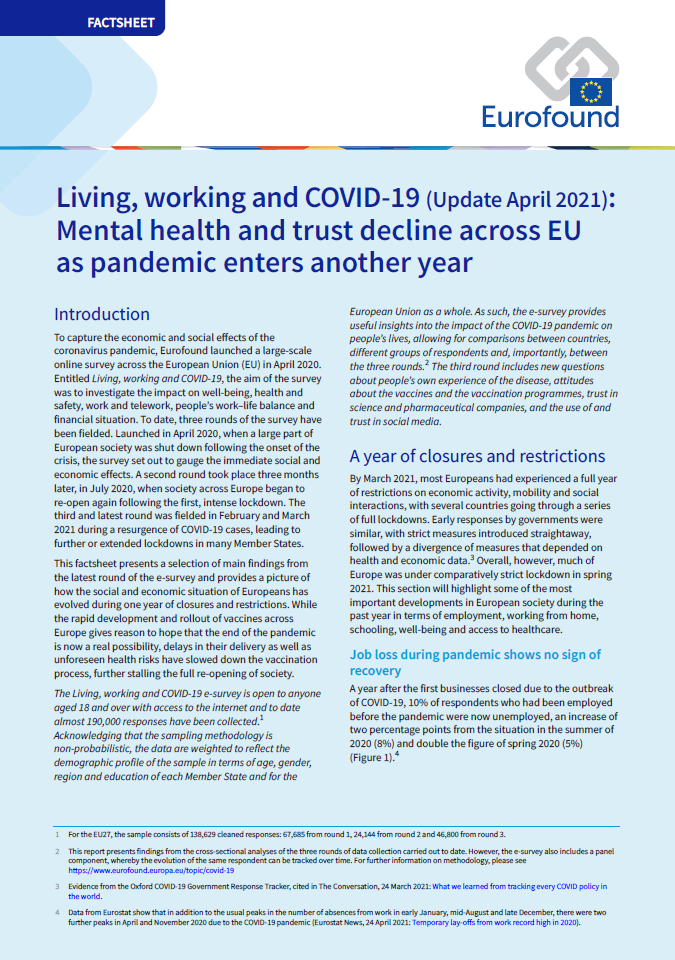
Eurofoundi e-küsitluse kolmas voor, mis toimus 2021. aasta veebruaris ja märtsis, heidab valgust peaaegu terve aasta COVID-19 piirangutega elanud Euroopa rahvastiku sotsiaalsele ja majanduslikule olukorrale. Aruanne analüüsib peamisi leide ning jälgib käimasolevaid arenguid ja suundumusi 27 Euroopa Liidu liikmesriigis alates küsitluse algusest aprillis 2020. See toob välja kogu pandeemia jooksul esilekerkinud probleemid, nagu tööga seotud suurem ebakindlus töökaotuse ohu tõttu, vaimse heaolu tasemete langus, soolise võrdõiguslikkuse hiljutiste saavutuste murenemine, usalduse vähenemine institutsioonide vastu, töö ja eraelu tasakaalu halvenemine ja vaktsiinikõhkluse suurenemine. Küsitluse tulemused toovad esile vajaduse holistilise lähenemise järele, et toetada kõiki kriisilt tugeva hoobi saanud rühmi eesmärgiga hoida ära nende edasist nõrgenemist.
Key findings
Vaimne heaolu on langenud madalaimale tasemele kõigis vanuserühmades alates pandeemia tekkest üle aasta tagasi. See on eriti tugevalt avaldunud noorte, samuti töö kaotanud inimeste seas.
Senine ebavõrdsus laieneb, kuna pandeemia mõjutab haavatavaid rühmi ebaproportsionaalselt. Leiud näitavad, et ots otsaga kokkutulemise raskused on ebakindlas olukorras olijate seas veelgi suurenenud.
Kodanike rahulolu kriisi kõrvalmeetmetega on oluliselt vähenenud – kõigest 12% inimestest tunneb praegu, et kõrvalmeetmed on õiglased, võrreldes 22%-ga 2020. aasta suvel. Ka nende hulk, kes tunnevad, et abi saamine on lihtne ja tõhus, langes 2020. aasta suve 16%-lt 2021. aasta kevadeks 10%-le. Vastajatest ligi ühe kümnendiku finantstoe taotlus lükati tagasi.
Institutsioonide, eriti valitsuse usaldamine on vähenenud – 2020. aasta suve 4,6 punktilt 2021. aasta kevadeks 3,9 punktile. Valitsuste usaldamine kõigis liikmesriikides vähenes allapoole pandeemia alguses registreeritud tasemeid. Euroopa Liidu usaldamine kahanes samuti, kuid jäi siiski kõrgemaks kui usaldus riikide valitsuste vastu.
Enam kui veerand Euroopas elavatest inimestest avaldab COVID-19 vaktsiini suhtes kõhklust, kusjuures mehed on kahtlevamal seisukohal (29%) kui naised (25%). Vaktsiinikõhklus on tugevalt seotud ka usalduse madala taseme ja suhtlusmeedia kasutamisega ning riikides, kus on registreeritud vähene usaldus valitsuse vastu, on registreeritud ka suurem vaktsiinikõhkluse tase.
The report contains the following lists of tables and figures. The corresponding data for the tables and figures is available as an Excel download (328KB .xlsx).
List of tables
- Table 1: Location of work and average hours worked during the pandemic, EU27 (%)
- Table 2: Proportion of parents declaring they are too tired after work to do household jobs, EU27 (%)
- Table 3: Proportion of respondents reporting having negative feelings by age and gender, EU27 (%)
- Table 4: Request for support by employment status, EU27 (%)
- Table 5: Proportion of financially fragile respondents by employment status, EU27 (%)
- Table 6: Proportion of respondents reporting difficulties making ends meet by employment status, EU27 (%)
- Table 7: Proportion of respondents reporting arrears by group, EU27 (%)
- Table 8: Trust in the EU by sociodemographic group (mean scores), EU27 (%)
- Table 9: Trust in the national government and the EU by financial support (mean scores), EU27 (%)
List of figures
- Figure 1: Respondents who lost their job (of those who were employed before the pandemic) by country, EU27 (%)
- Figure 2: Preference to work from home post-pandemic, EU27 (%)
- Figure 3: Proportion of parents declaring they would like more online schooling for their children, even when the pandemic is over, EU27 (%)
- Figure 4: Risk of depression by age group and survey round, EU27 (%)
- Figure 5: Unmet need for healthcare during the pandemic by country, EU27 (%)
- Figure 6: Unmet need for healthcare by type of healthcare, spring 2021, EU27 (%)
- Figure 7: Requests for different types of support measures, summer 2020 and spring 2021, EU27 (%)
- Figure 8: Views about pandemic support measures, summer 2020 and spring 2021, EU27 (%)
- Figure 9: Views about pandemic support measures by country, spring 2021, EU27 (%)
- Figure 10: Proportion of respondents reporting difficulties making ends meet by country, EU27 (%)
- Figure 11: Pessimism about financial situation by economic situation, EU27 (%)
- Figure 12: Proportion of respondents stating that their financial situation will get worse, EU27 (%)
- Figure 13: Trust in institutions (mean scores), EU27 (%)
- Figure 14: Trust in the EU by country (mean scores), EU27 (%)
- Figure 15: Trust in national governments by country and survey round, EU27 (%)
- Figure 16: Stated intention to take vaccine by country, EU27 (%)
- Figure 17: Sociodemographic characteristics of people with vaccine hesitancy in Europe, EU27 (%)
- Figure 18: Reasons for vaccine hesitancy, EU27 (%)
- Figure 19: Trust in institutions among people who are vaccine hesitant and non-hesitant, EU27 (%)
- Figure 20: Vaccination hesitancy before and after 11 March 2021, EU27 (%)
- Infographic: Living, working and COVID-19
